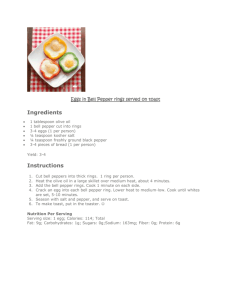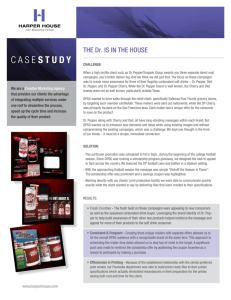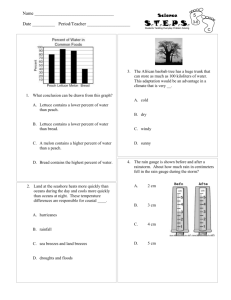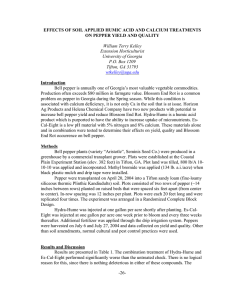Document 14105668
advertisement
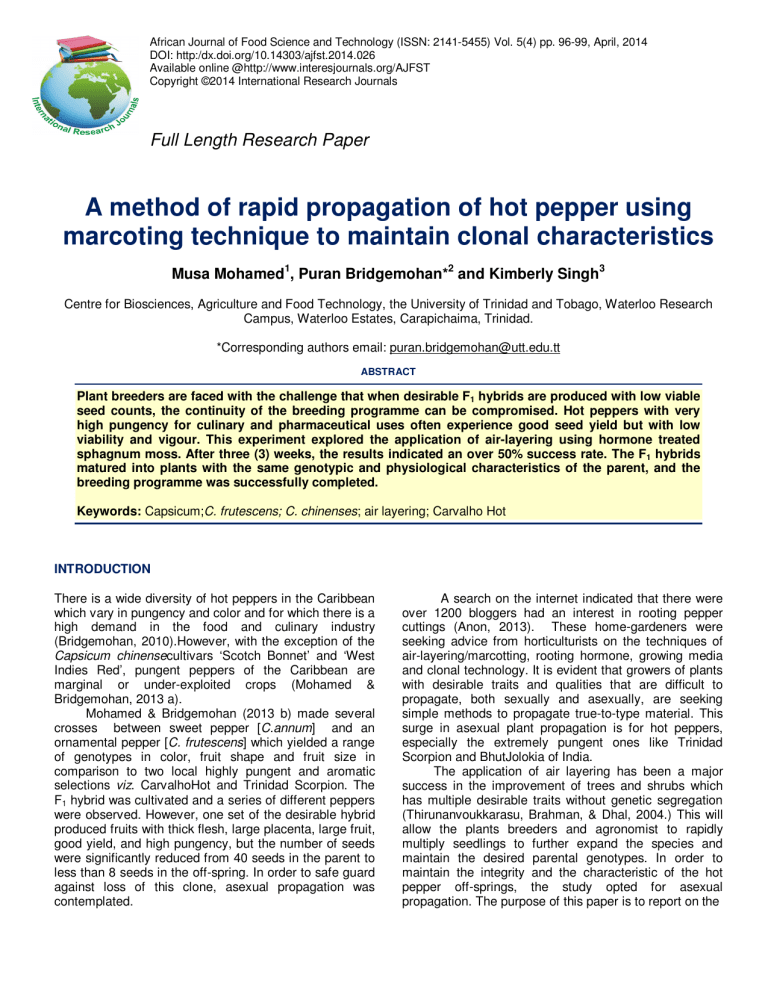
African Journal of Food Science and Technology (ISSN: 2141-5455) Vol. 5(4) pp. 96-99, April, 2014 DOI: http:/dx.doi.org/10.14303/ajfst.2014.026 Available online @http://www.interesjournals.org/AJFST Copyright ©2014 International Research Journals Full Length Research Paper A method of rapid propagation of hot pepper using marcoting technique to maintain clonal characteristics Musa Mohamed1, Puran Bridgemohan*2 and Kimberly Singh3 Centre for Biosciences, Agriculture and Food Technology, the University of Trinidad and Tobago, Waterloo Research Campus, Waterloo Estates, Carapichaima, Trinidad. *Corresponding authors email: puran.bridgemohan@utt.edu.tt ABSTRACT Plant breeders are faced with the challenge that when desirable F1 hybrids are produced with low viable seed counts, the continuity of the breeding programme can be compromised. Hot peppers with very high pungency for culinary and pharmaceutical uses often experience good seed yield but with low viability and vigour. This experiment explored the application of air-layering using hormone treated sphagnum moss. After three (3) weeks, the results indicated an over 50% success rate. The F1 hybrids matured into plants with the same genotypic and physiological characteristics of the parent, and the breeding programme was successfully completed. Keywords: Capsicum;C. frutescens; C. chinenses; air layering; Carvalho Hot INTRODUCTION There is a wide diversity of hot peppers in the Caribbean which vary in pungency and color and for which there is a high demand in the food and culinary industry (Bridgemohan, 2010).However, with the exception of the Capsicum chinensecultivars ‘Scotch Bonnet’ and ‘West Indies Red’, pungent peppers of the Caribbean are marginal or under-exploited crops (Mohamed & Bridgemohan, 2013 a). Mohamed & Bridgemohan (2013 b) made several crosses between sweet pepper [C.annum] and an ornamental pepper [C. frutescens] which yielded a range of genotypes in color, fruit shape and fruit size in comparison to two local highly pungent and aromatic selections viz. CarvalhoHot and Trinidad Scorpion. The F1 hybrid was cultivated and a series of different peppers were observed. However, one set of the desirable hybrid produced fruits with thick flesh, large placenta, large fruit, good yield, and high pungency, but the number of seeds were significantly reduced from 40 seeds in the parent to less than 8 seeds in the off-spring. In order to safe guard against loss of this clone, asexual propagation was contemplated. A search on the internet indicated that there were over 1200 bloggers had an interest in rooting pepper cuttings (Anon, 2013). These home-gardeners were seeking advice from horticulturists on the techniques of air-layering/marcotting, rooting hormone, growing media and clonal technology. It is evident that growers of plants with desirable traits and qualities that are difficult to propagate, both sexually and asexually, are seeking simple methods to propagate true-to-type material. This surge in asexual plant propagation is for hot peppers, especially the extremely pungent ones like Trinidad Scorpion and BhutJolokia of India. The application of air layering has been a major success in the improvement of trees and shrubs which has multiple desirable traits without genetic segregation (Thirunanvoukkarasu, Brahman, & Dhal, 2004.) This will allow the plants breeders and agronomist to rapidly multiply seedlings to further expand the species and maintain the desired parental genotypes. In order to maintain the integrity and the characteristic of the hot pepper off-springs, the study opted for asexual propagation. The purpose of this paper is to report on the Mohamed et al. 97 Figure 1.Placement of auxin treated rooting medium around the incision of hot pepepr plant. Figure 2. Completed air layer using perforated black polythene with taped ends success of asexual propagations of F1 hybrid plants by air-layering (marcotting). MATERIAL AND METHODS This study was conducted at the Waterloo Research Campus of The University of Trinidad and Tobago, during the period May 2012 to April 2013, under greenhouse conditions. The test plants were the F1 hybrids of a 3-way cross of a local hot pepper selection named “Carvalho Hot” with ornamental and sweet peppers. The seedlings were cultivated in pots using sandy loam soil as the medium and the plants received the normal fertilizer (30g NPK: 20-12-20) treatments. No pesticides were used in this experiment. The parent plants were over 12 months old and were in the fruiting stage from the last 8 months. The plants were over 1.5m tall, and had many mature branches all filled with flowers and young and mature fruits. The trees were indeterminate and the mature stems continued to produce young branches. All five of the mature plants were selected for the layering exercise. The layering was made just under the main nodes of young and mature shoots that varied from 24 to 30 cm in length. A small ring of the stem bark was stripped away without damage to the xylem vessels using a sterilized budding knife. The node diameter was 0 .5 to1.0 cm, and all shoots had in excess of 10 leaves, whilst some had flowers which were removed. Only shoots in fully vegetative stages were selected for treatment. In the preparation of the air layering, the rooting medium used was sphagnum moss (30 g) which was treated with the rooting hormone (Indole -3-acetic acid solutions [IAA] in concentrations of 3000ppm) prepared by dilute solution method (Hartman &Kester, 1972). This was placed in the dried sphagnum moss and soaked for 24 hours (Figure 1). A handful of the soaked moss was squeezed out and wrapped tightly with the black polypropylene film around the ole-barked nodes (Figures 3 and 4) and fastened on both ends with an adhesive tape. The polypropylene wrap was perforated to allow for aeration 98 Afr. J. Food Sci. Technol. Figure 3. Callus formation and rooted air layering of hot pepper Figure 4. Excised rooted air layered hot pepper plant ready for transplanting a b c Figure 5 a, b, c: Rooted air layered F1hybrid pepper plant with fruits and watering daily. A total of 40 layerings were performed and after 21 days, the wraps were removed to observe for callus formation and root growth. Where ever mature rootlets with root hairs were present (Figure 3), the shoots were excised (Figure 4) and transplanted into grow buckets with sand (sharp sand) for further growing-out and hardening at a cool place in the greenhouse. The rooted cuttings were observed for growth and were adequately watered daily, and given a weekly foliar spray treatment of the fertilizer. RESULTS AND DISCUSSION The results of this experiment are presented by a series of photographs which depicted all the steps from the preparation of the shoot, rooting medium and hormonal treatment to callus formation (Figures 1 to 5 below). Of the 40 air-layers which were conducted and after the 3 weeks had elapsed, 24 of the plants had callus with good root formation, 6 had healings of the wound and no roots, and there were 10 die backs. The die backs could be as a result of any of the following: over-sized or too thick shoot, a deeper incision that damaged the xylem vessels or the rooting medium had dried out. It did not appear as if the hormone was very effective under these conditions. The rooted cuttings had good root formation and the flowers that were inadvertently not removed, progressed into ripe fruits after 3 weeks (Figures 5a, b, c). The rooted cuttings grown out in the sand culture maintained their growth pattern and continued into the physiological stage of reproduction. Mohamed et al. 99 This experiment has demonstrated the success of airlayering (marcotting) hot pepper plants to propagate the clone when the seed production is low, and the maintenance of the quality characteristics and integrity of the parent is dissemble. It is one of the only documented reports in the success of air-layering of hot peppers. CONCLUSION In this study, where auxin was not applied to the cut surface, but rather in the rooting medium, hot pepper plants which were not previously easily rooted demonstrated an over 50% success callus and root formation. This rapid method of propagation is useful in the improvement and conservation of multiple desirable characteristic of pepper plants without genetic segregation and the maintenance of clonal characteristics. REFERENCES Anon (2013).Rooting pepper cutting bloggers .INTERNET. Bridgemohan P (2010). Capsaicin Production for Pharmaceutical Use. th Paper presented at the 47 Annual Caribbean Food Crop Society th Conference, 12th to 17 July, Dominican Republic. Hartman HE, Kester T(1972). Plant Propagation: Principles and Practices. Second Edition.Prentice and Hall of India Private Limited, New Delhi. Mohamed M, Bridgemohan P (2013 a). Breeding multi-purpose hot peppers for increased capsaicinoids content. Mohamed M, Bridgemohan, P (2013 b). Hot peppers: III. Rapid qualitative assessment methodology to determine postharvest levels of capsaicinoid content in ornamental hot pepper crosses. Thirunanvoukkarasu M, Brahman M, Dhal NK, (2004).Vegetative propagation of Hymenacourbaril by air layering. Journal of Tropical Forest Science 16(2): 268-270. How to cite this article: Mohamed M., Bridgemohan P. and Singh K. (2014). A method of rapid propagation of hot pepper using marcoting technique to maintain clonal characteristics. Afr. J. Food Sci. Technol. 5(4):96-99

